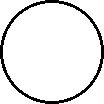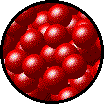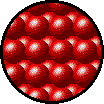 |  |  |
| Microscopic view of a gas. | Microscopic view of a liquid. | Microscopic view of a solid. |
- Particles in a:
- gas are well separated with no regular arrangement.
- liquid are close together with no regular arrangement.
- solid are tightly packed, usually in a regular pattern.
- Particles in a:
- gas vibrate and move freely at high speeds.
- liquid vibrate, move about, and slide past each other.
- solid vibrate (jiggle) but generally do not move from place to place.
Liquids and solids are often referred to as condensed phases because the particles are very close together.
| Some Characteristics of Gases, Liquids and Solids and the Microscopic Explanation for the Behavior | ||
|---|---|---|
| gas | liquid | solid |
| assumes the shape and volume of its container particles can move past one another | assumes the shape of the part of the container which it occupies particles can move/slide past one another | retains a fixed volume and shape rigid - particles locked into place |
| compressible lots of free space between particles | not easily compressible little free space between particles | not easily compressible little free space between particles |
| flows easily particles can move past one another | flows easily particles can move/slide past one another | does not flow easily rigid - particles cannot move/slide past one another |

You can complement information about states of matter in the images below, we know it is more practice if you prefer images than text.
Thanks for visit these blog,
it information was found in these web site: https://www.chem.purdue.edu/gchelp/atoms/states.html





No hay comentarios:
Publicar un comentario